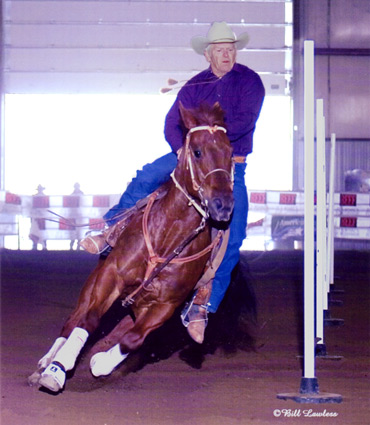| Home Competition Index | First Posted June 23, 2008 Jan 21, 2020 | |
Pole Bending Photo courtesy of Ken Smith and Sunrise West Quarter Horses, LLC. Sunrise West Quarter Horses, LLC This following article is a direct quote from the National Pole Bending Association website. National Pole Bending Association "Pole bending is a timed event. (a) Each contestant will begin from a running start, and time shall begin and end as the horse's nose crosses the line. A clearly visible starting line must be provided. An electric timer or at least two watches shall be used, with the time indicated by the electric timer or the average time of the watches used by official timers to be the official time.(b) The pole bending pattern is to be run around six poles. Each pole is to be 21 feet (6.4 meters) apart, and the first pole is to be 21 feet (6.4 meters) from the starting line. Poles shall be set on top of the ground, six feet (1.8 meters) in height, with no base more than 14 inches (35 cm) in diameter. (c) A horse may start either to the right or to the left of the first pole and then run the remainder of the pattern accordingly. (d) Knocking over a pole shall carry a five-second penalty. Failure to follow the course shall cause disqualification. A contestant may touch a pole with his or her hand in pole bending. (e) A five-second penalty will be assessed if the hat or helmet is not on the exhibitor's person for the entire time the exhibitor is in the arena in pole bending. (f) In the event of a tie, the horse declared the winner in the runoff must rerun the pattern within two seconds of its original time or the runoff must be held again. Penalty time will not apply to the two-second rule, but will apply to the final runoff time. (g) The judge, at his/her discretion, may disqualify a contestant for excessive use of a bat, crop, whip or rope in front of the cinch. Poles shall be shall be set on top of the ground, 6 feet in height, and mounted in bases with a 14 inch diameter. Poles shall be PVC pipe, and bases shall be rubber or plastic. For added safety, PVC caps are recommended. Preferred color for poles is natural white, but red, white, and blue rings shall be allowed. Solid rubber bases are preferred, but hollow plastic bases shall be allowed only if filled completely to emulate a solid base. To illustrate, here is an example of a system that would comply with the preceding specification: Poles cut to 6 foot lengths from schedule 40 PVC, with glued-on rounded caps, mounted in hard rubber Josey bases. Pole bending is timed event that features a horse and one mounted rider, running a weaving or serpentine path around six poles arranged in a line. This event is usually seen in high school rodeos as well as American Quarter Horse Association, local National Barrel Horse Association shows, Paint and Appaloosa sanctioned shows as well as at many gymkhana or O-Mok-See events. The rider will take up a gallop and run past all the poles turning at the last pole. The rider and horse will make a serpentine path through the poles, that is, passing on alternating hands and leads through the poles. When the last pole is reached, the horse and rider continue in a mirror pattern through the poles back to the first one. When the pattern is completed the horse and rider then gallop back past the poles and through the timer. If the rider knocks over a pole he will be penalized, resulting in either disqualification from the event or a 5-second penalty (per knocked pole)."
Pole Bending Course
 21 feet =6.4 meters
|